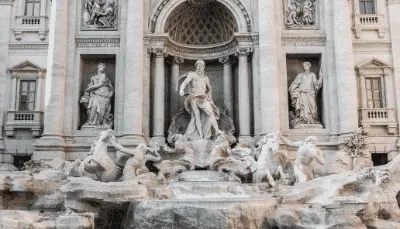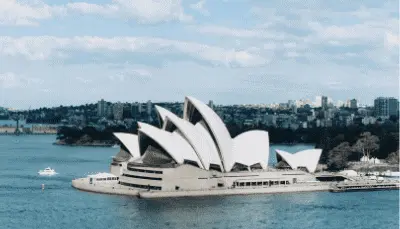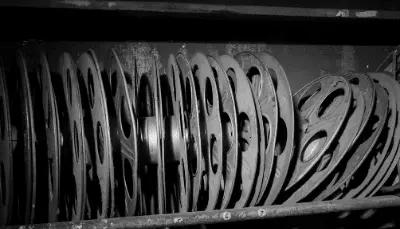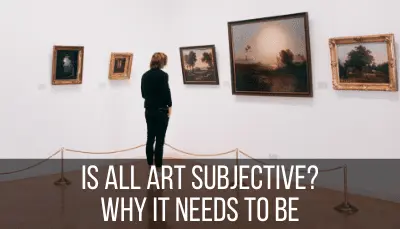There are so many amazing and diverse types of art, but they can generally be categorized into one of seven categories. Understanding each distinct category of art is important to understanding its role in our lives and history. The seven categories of art are:
1. Painting
2. Sculpture
3. Literature
4. Architecture
5. Cinema
6. Theater
7. Music
From the days of cave paintings to our tech-inspired digital art, our history as artists and creatives has changed overtime. That said, the categories themselves have stayed the same. It’s pretty incredible when you think about it. Let’s dive into each of these 7 art forms and discover where they came from.
Note that these seven forms of art are listed in no particular order.
1. Painting
Researchers have found cave paintings dating back to more than 40,000 years ago (source). In those days, there weren’t any art stores to buy supplies. Instead, these prehistoric artists had to rely on whatever they could find.
Dirt, charcoal, ochre, animal fat, and different types of natural materials came together to make pigments. Then, water could be used to turn these pigments into pastes that were a consistency similar to paint (source). This made it easier to spread on cave walls and create the artwork we marvel at today.
Throughout history, painting has continued to be a mainstay of artistic culture. From the Mona Lisa to the Sistine Chapel and Andy Warhol’s Campbell soup cans, it’s impossible to think about the history of our artistic society without thinking about painting.

2. Sculpture
Sculpture does a good job of piggybacking off of painting, both in subject matter and longevity within human history (source). The oldest known sculpture was found in Germany and dated to over 35,000 years old (source). In the very early days, sculpture wasn’t just an art form, but a source of utility.
Once fire was discovered, it became easier to use clay to make pottery, utensils, and other tools. But, sculpture didn’t stop there.
Overtime, as tools and access to materials progressed, so too did the art of sculpture. Artists could chip away at stone, marble, wood, and even bronze. Now, sculpture remains an important part of our history and a great art form for artists to pursue today.

3. Literature
The first known author of literature dates back to 2285 BCE (source). As influential painting has been throughout our history, it’s arguable that literature matches that influence, if not surpasses it. Words have power and humans have been utilizing that power for thousands of years.
The category of “literature” encompasses a wide range of written works – poetry, drama, biographies, fiction, non-fiction, satires, essays, and more. In the modern day with the rise in technology, increased printing abilities, and an expanse in publishing, literature only continues to grow as a means of sharing our thoughts, opinions, and knowledge.
Whether you’re a die hard Harry Potter fan or a devoted Shakespeare researcher, literature stands as an important fixture in our artistic lives and holds a firm place in the seven forms of art.
4. Architecture
If you’ve ever admired the great Roman cathedrals or ogled at the dramatic curves of the Sydney Opera House, you know that architecture is an art form. If you’re cynical about architecture after being surrounded by cookiecutter suburbs, put on the Travel Channel and soak up some of the world’s most famous structures.
The origins of architecture depend on what you define as a “building.” Conceivably, we can date architecture back to the point when man first created shelter, even if that shelter was just a few sticks and palm fronds.
If we’re thinking about architecture that can still be appreciated today, we can look as far back as Stonehenge, which dates back to 3000 BCE (source). Even though we may not think of Stonehenge as typical architecture, it’s an early representation of man’s desire to build meaningful structures.
Like sculpture, architecture is both a utility and an art form. We need buildings and structures to live in, so we might as well make them beautiful, right? Of course, not all buildings are beautiful, but there’s no doubt that the most renowned examples of architecture are truly a work of art.

5. Cinema
Given its reliance on technology, cinema has the most recent origins of all of the seven art forms. In 1891, cinema made its debut into the world through the form of a kinetoscope, which was a device that allowed people to watch movies one at a time. Then, in 1895, the Lumière Brothers introduced the first ever movie to be presented to a large group (source).
From that momentous moment in 1895, cinema has advanced to the large industry we know it today. Special effects, animation, makeup, costumes, screenwriting, directing, and more. The amount of artistic vision and skill that needs to go into one cinematic production is astounding.
The next time you go to the movies, think about how far this art form has come in just over a hundred years.

6. Theater
The history of theater leads us back to the Ancient Greeks in the 6th century BC (source). Those amazing amphitheaters we see so well preserved were once the stages for the earliest performances.
From its earliest origins in Greece, theater only became more popular. Think of Shakespeare and, in our modern day, famous Broadway in NYC. Like cinema, theater and performing arts rely on a number of art forms coming together to produce a successful show. Set designers, playwrights, costume makers, and more.
And theater isn’t reserved to acting. Especially with the introduction of musical theater, we saw this art form embrace music and dancing as well.
Unlike cinema, humans have been using theater and the performing arts as a source of entertainment for thousands of years. Heck, it could date back earlier but we don’t have fossil evidence to prove it. Who knows what our earliest ancestors were doing to entertain themselves.
As one of the seven forms of art, theater shows the long and important history of entertainment and social gatherings.

7. Music
It’s likely that music was a part of our ancestors’ lives from a very early point in history. It’s likely that vocal sounds played an important role in our communication and survival prior to the development of speech. It’s also been found that our ancestors crafted instruments from bones, stones, and other natural materials (source).
As civilizations developed, music became an important part of religious practices. In the Middle Ages, for example, Gregorian chanting became a common religious practice. Progressing through the Renaissance, the Baroque period, Classical period, Romantic period, and what we now know in the 20th century, music has grown and expanded in both religious and secular contexts (source).
No matter what you think about pop music today, music is an interesting window into the culture of society. Eventually, it will serve as a window into the world we lived in, just as music of the past does for us now.

And, isn’t that true of all of these art forms? Paintings, movies, buildings, sculptures, literature, and music. All seven of these art forms show us how our world and society has changed overtime, for better and for worse. And that, in it of itself, is a form of art.

Diana has been an artist for over 27 years and has training in drawing, painting, digital drawing and graphic design. Diana’s latest obsession is digitally drawing with Procreate and Procreate Dreams. Diana has experience selling her art across a number of platforms and loves helping other artists learn how to make money from their art as well.

